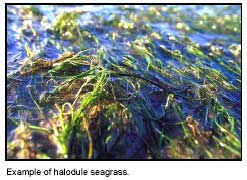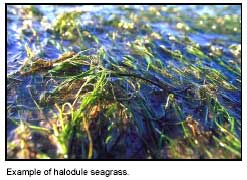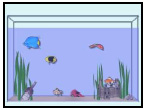Water: Middle School
Exercise II. Locating Pfiesteria!
A term that many scientists use for an outbreak of Pfiesteria is a 'harmful algal bloom' (HAB for short). Pfiesteria organisms have been found as far north as Delaware and as far south as the Gulf of Mexico. In recent years HABs have been occurring most often in Maryland, North Carolina, and the Chesapeake Bay.
Using a map of the United States, identify these areas. Name the states around the Chesapeake Bay.
The HAB-Nutrient connection
The two main nutrients polluting the Chesapeake Bay are nitrogen and phosphorus. Algae in the Bay use these nutrients to grow. These two nutrients are abundant in commercial fertilizer, which is spread on farmlands, lawns, and other grassed areas such as golf courses and ballfields. They are also found in waste such as cow manure from farm fields which wash off into streams that lead to the bay, or chicken manure from poultry farms in the areas adjoining the bay. (Many counties adjoining the bay have numerous large poultry farms, including the eastern shore of Maryland, Virginia and Delaware, and parts of North Carolina.)
If too many nutrients flow into an environment like the bay, algae in the water multiply and bloom more intensively. The algae can cloud the water and prevent sunlight from reaching vegetation in the water, such as submerged aquatic grasses.
 When this vegetation is unable to photosynthesize, (convert sunlight and carbon dioxide into oxygen) oxygen levels in the water decrease. Organisms that feed off the grasses and breathe oxygen are stressed or die. That's why an overabundance of algae can become out of control and turn into a Harmful Algal Bloom.
When this vegetation is unable to photosynthesize, (convert sunlight and carbon dioxide into oxygen) oxygen levels in the water decrease. Organisms that feed off the grasses and breathe oxygen are stressed or die. That's why an overabundance of algae can become out of control and turn into a Harmful Algal Bloom.
The HAB-Pfiesteria Connection
Algae may also become harmful if they produce a toxin. A high abundance of algae like Pfiesteria, that produce chemicals that are toxic to humans and aquatic life can also be called a Harmful Algal Bloom. Although the term "bloom" can conjure up an image of a dense algal population this is not always the case with HABs. Even a concentration of a few cells per liter of some microalgae can produce harmful toxic effects.
Step 1. Identify Pfiesteria occurrences in the Chesapeake Bay:Step 2. Getting information from maps
- Interpret the map legend.
- Name the two methods by which Pfiesteria in these outbreaks were identified?
Step 3. Nutrients in an estuary setting

What is an estuary?
Think about the movement of water in an estuary setting. Does it flow rapidly or sluggishly? Compare the water environment in terms of water movement, in a home aquarium, an estuary and in a pond. What are sources of water movement in each?
| Pond |
Home Aquarium |
Estuary |
|---|
Oxygen gets into rivers when water crashes over rocks, when wind blows over the water, and by any other method which causes air to mix with the water. Based on this fact, fast moving rivers have more oxygen content than slow moving rivers.
Compare rivers with a home aquarium. What are sources of oxygen in your aquarium?
Hint:
Do you bubble air through your aquarium? Do you have plants in your aquarium?
How often do you clean your aquarium? What is the purpose of cleaning it?
How do estuaries maintain healthy levels of oxygen in the water? (What are sources of oxygen in the estuary's waters?)
Fill in the blanks! Describe in each box, what happens when excess nutrients flow into an estuary environment (like the Chesapeake Bay)
| Excess Nutrients | |
|---|---|
| Submerged vegetation | |
| Algae | |
| Numbers of Pfiesteria |
Would you claim that Pfiesteria thrive in the presence of lots of nutrients? Why or why not? (Hint: what do Pfiesteria eat?)
Hints:
Web site 4: "Dinoflagellates, Protists and Pfiesteria"
Web site 6: "Pfiesteria piscicida, Fact Sheet", [BROKEN] Check section, 'What causes toxic Pfiesteria Outbreaks?'
Web site 1: "Pfiesteria"
Step 4. Identify Environmental Triggers.
On the Trigger Test worksheet, write down the environmental factors that contribute to Pfiesteria outbreaks. List below or download and print the
